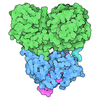+ Open data
Open data
- Basic information
Basic information
| Entry | Database: PDB / ID: 8jpb | ||||||
|---|---|---|---|---|---|---|---|
| Title | cryo-EM structure of NTSR1-GRK2-Galpha(q) complexes 1 | ||||||
 Components Components |
| ||||||
 Keywords Keywords | SIGNALING PROTEIN / Biased signaling | ||||||
| Function / homology |  Function and homology information Function and homology informationCalmodulin induced events / negative regulation of the force of heart contraction by chemical signal / negative regulation of relaxation of smooth muscle / beta-adrenergic-receptor kinase / Activation of SMO / G protein-coupled neurotensin receptor activity / Edg-2 lysophosphatidic acid receptor binding / inositol phosphate catabolic process / alpha-2A adrenergic receptor binding / symmetric synapse ...Calmodulin induced events / negative regulation of the force of heart contraction by chemical signal / negative regulation of relaxation of smooth muscle / beta-adrenergic-receptor kinase / Activation of SMO / G protein-coupled neurotensin receptor activity / Edg-2 lysophosphatidic acid receptor binding / inositol phosphate catabolic process / alpha-2A adrenergic receptor binding / symmetric synapse / beta-adrenergic receptor kinase activity / G protein-coupled receptor kinase activity / tachykinin receptor signaling pathway / Fatty Acids bound to GPR40 (FFAR1) regulate insulin secretion / Acetylcholine regulates insulin secretion / negative regulation of striated muscle contraction / phospholipase C-activating G protein-coupled glutamate receptor signaling pathway / D-aspartate import across plasma membrane / positive regulation of gamma-aminobutyric acid secretion / Cargo recognition for clathrin-mediated endocytosis / positive regulation of protein localization to cilium / PLC beta mediated events / desensitization of G protein-coupled receptor signaling pathway / phospholipase C-activating serotonin receptor signaling pathway / regulation of membrane depolarization / cytoplasmic side of mitochondrial outer membrane / positive regulation of arachidonate secretion / regulation of platelet activation / entrainment of circadian clock / L-glutamate import across plasma membrane / regulation of the force of heart contraction / regulation of respiratory gaseous exchange / positive regulation of inhibitory postsynaptic potential / positive regulation of smoothened signaling pathway / negative regulation of systemic arterial blood pressure / G protein-coupled receptor internalization / negative regulation of release of sequestered calcium ion into cytosol / positive regulation of glutamate secretion / regulation of canonical Wnt signaling pathway / G alpha (s) signalling events / glutamate receptor signaling pathway / G alpha (q) signalling events / temperature homeostasis / response to lipid / positive regulation of inositol phosphate biosynthetic process / detection of temperature stimulus involved in sensory perception of pain / phototransduction, visible light / photoreceptor outer segment / regulation of signal transduction / neuropeptide signaling pathway / postsynaptic cytosol / cardiac muscle contraction / adenylate cyclase-activating adrenergic receptor signaling pathway / enzyme regulator activity / response to prostaglandin E / GTPase activator activity / viral genome replication / Peptide ligand-binding receptors / positive regulation of release of sequestered calcium ion into cytosol / Turbulent (oscillatory, disturbed) flow shear stress activates signaling by PIEZO1 and integrins in endothelial cells / dendritic shaft / adult locomotory behavior / learning / cell projection / intracellular protein transport / G protein-coupled receptor binding / G protein-coupled receptor activity / cytoplasmic side of plasma membrane / G-protein beta/gamma-subunit complex binding / adenylate cyclase-activating G protein-coupled receptor signaling pathway / terminal bouton / Thromboxane signalling through TP receptor / G protein-coupled acetylcholine receptor signaling pathway / G-protein activation / blood coagulation / ADP signalling through P2Y purinoceptor 1 / Cooperation of PDCL (PhLP1) and TRiC/CCT in G-protein beta folding / heterotrimeric G-protein complex / presynapse / Thrombin signalling through proteinase activated receptors (PARs) / heart development / G protein activity / nuclear membrane / High laminar flow shear stress activates signaling by PIEZO1 and PECAM1:CDH5:KDR in endothelial cells / phospholipase C-activating G protein-coupled receptor signaling pathway / perikaryon / G alpha (q) signalling events / dendritic spine / chemical synaptic transmission / Hydrolases; Acting on acid anhydrides; Acting on GTP to facilitate cellular and subcellular movement / protein phosphorylation / protein kinase activity / postsynapse / protein stabilization / positive regulation of apoptotic process / membrane raft / G protein-coupled receptor signaling pathway / lysosomal membrane / GTPase activity / positive regulation of gene expression Similarity search - Function | ||||||
| Biological species |   Homo sapiens (human) Homo sapiens (human)synthetic construct (others) | ||||||
| Method | ELECTRON MICROSCOPY / single particle reconstruction / cryo EM / Resolution: 3.07 Å | ||||||
 Authors Authors | Duan, J. / Liu, H. / Zhao, F. / Yuan, Q. / Ji, Y. / Xu, H.E. | ||||||
| Funding support |  China, 1items China, 1items
| ||||||
 Citation Citation |  Journal: Nature / Year: 2023 Journal: Nature / Year: 2023Title: GPCR activation and GRK2 assembly by a biased intracellular agonist. Authors: Jia Duan / Heng Liu / Fenghui Zhao / Qingning Yuan / Yujie Ji / Xiaoqing Cai / Xinheng He / Xinzhu Li / Junrui Li / Kai Wu / Tianyu Gao / Shengnan Zhu / Shi Lin / Ming-Wei Wang / Xi Cheng / ...Authors: Jia Duan / Heng Liu / Fenghui Zhao / Qingning Yuan / Yujie Ji / Xiaoqing Cai / Xinheng He / Xinzhu Li / Junrui Li / Kai Wu / Tianyu Gao / Shengnan Zhu / Shi Lin / Ming-Wei Wang / Xi Cheng / Wanchao Yin / Yi Jiang / Dehua Yang / H Eric Xu /  Abstract: Phosphorylation of G-protein-coupled receptors (GPCRs) by GPCR kinases (GRKs) desensitizes G-protein signalling and promotes arrestin signalling, which is also modulated by biased ligands. The ...Phosphorylation of G-protein-coupled receptors (GPCRs) by GPCR kinases (GRKs) desensitizes G-protein signalling and promotes arrestin signalling, which is also modulated by biased ligands. The molecular assembly of GRKs on GPCRs and the basis of GRK-mediated biased signalling remain largely unknown owing to the weak GPCR-GRK interactions. Here we report the complex structure of neurotensin receptor 1 (NTSR1) bound to GRK2, Gα and the arrestin-biased ligand SBI-553. The density map reveals the arrangement of the intact GRK2 with the receptor, with the N-terminal helix of GRK2 docking into the open cytoplasmic pocket formed by the outward movement of the receptor transmembrane helix 6, analogous to the binding of the G protein to the receptor. SBI-553 binds at the interface between GRK2 and NTSR1 to enhance GRK2 binding. The binding mode of SBI-553 is compatible with arrestin binding but clashes with the binding of Gα protein, thus providing a mechanism for its arrestin-biased signalling capability. In sum, our structure provides a rational model for understanding the details of GPCR-GRK interactions and GRK2-mediated biased signalling. | ||||||
| History |
|
- Structure visualization
Structure visualization
| Structure viewer | Molecule:  Molmil Molmil Jmol/JSmol Jmol/JSmol |
|---|
- Downloads & links
Downloads & links
- Download
Download
| PDBx/mmCIF format |  8jpb.cif.gz 8jpb.cif.gz | 259.7 KB | Display |  PDBx/mmCIF format PDBx/mmCIF format |
|---|---|---|---|---|
| PDB format |  pdb8jpb.ent.gz pdb8jpb.ent.gz | 196.7 KB | Display |  PDB format PDB format |
| PDBx/mmJSON format |  8jpb.json.gz 8jpb.json.gz | Tree view |  PDBx/mmJSON format PDBx/mmJSON format | |
| Others |  Other downloads Other downloads |
-Validation report
| Summary document |  8jpb_validation.pdf.gz 8jpb_validation.pdf.gz | 1.5 MB | Display |  wwPDB validaton report wwPDB validaton report |
|---|---|---|---|---|
| Full document |  8jpb_full_validation.pdf.gz 8jpb_full_validation.pdf.gz | 1.5 MB | Display | |
| Data in XML |  8jpb_validation.xml.gz 8jpb_validation.xml.gz | 46.6 KB | Display | |
| Data in CIF |  8jpb_validation.cif.gz 8jpb_validation.cif.gz | 67.7 KB | Display | |
| Arichive directory |  https://data.pdbj.org/pub/pdb/validation_reports/jp/8jpb https://data.pdbj.org/pub/pdb/validation_reports/jp/8jpb ftp://data.pdbj.org/pub/pdb/validation_reports/jp/8jpb ftp://data.pdbj.org/pub/pdb/validation_reports/jp/8jpb | HTTPS FTP |
-Related structure data
| Related structure data |  36474MC  8jpcC 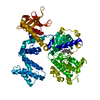 8jpdC 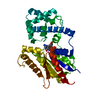 8jpeC  8jpfC M: map data used to model this data C: citing same article ( |
|---|---|
| Similar structure data | Similarity search - Function & homology  F&H Search F&H Search |
- Links
Links
- Assembly
Assembly
| Deposited unit | 
|
|---|---|
| 1 |
|
- Components
Components
-Protein , 3 types, 3 molecules GQR
| #1: Protein | Mass: 79644.727 Da / Num. of mol.: 1 / Mutation: A292P,R295I,S455D Source method: isolated from a genetically manipulated source Source: (gene. exp.)   References: UniProt: P21146, beta-adrenergic-receptor kinase |
|---|---|
| #3: Protein | Mass: 41282.895 Da / Num. of mol.: 1 Source method: isolated from a genetically manipulated source Source: (gene. exp.)  Homo sapiens (human) / Gene: GNAQ, GAQ / Production host: Homo sapiens (human) / Gene: GNAQ, GAQ / Production host:  |
| #4: Protein | Mass: 46307.594 Da / Num. of mol.: 1 Source method: isolated from a genetically manipulated source Source: (gene. exp.)  Homo sapiens (human) / Gene: NTSR1 / Production host: Homo sapiens (human) / Gene: NTSR1 / Production host:  |
-Protein/peptide , 1 types, 1 molecules L
| #2: Protein/peptide | Mass: 819.007 Da / Num. of mol.: 1 / Source method: obtained synthetically / Source: (synth.) synthetic construct (others) |
|---|
-Non-polymers , 5 types, 5 molecules 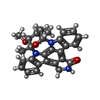


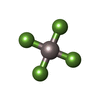





| #5: Chemical | ChemComp-STU / |
|---|---|
| #6: Chemical | ChemComp-GDP / |
| #7: Chemical | ChemComp-MG / |
| #8: Chemical | ChemComp-ALF / |
| #9: Chemical | ChemComp-SRW / |
-Details
| Has ligand of interest | N |
|---|
-Experimental details
-Experiment
| Experiment | Method: ELECTRON MICROSCOPY |
|---|---|
| EM experiment | Aggregation state: PARTICLE / 3D reconstruction method: single particle reconstruction |
- Sample preparation
Sample preparation
| Component | Name: NTSR1-GRK2-Galpha(q) complexes 1 / Type: COMPLEX / Entity ID: #1-#4 / Source: RECOMBINANT |
|---|---|
| Source (natural) | Organism:  Homo sapiens (human) Homo sapiens (human) |
| Source (recombinant) | Organism:  |
| Buffer solution | pH: 7.4 |
| Specimen | Embedding applied: NO / Shadowing applied: NO / Staining applied: NO / Vitrification applied: YES |
| Vitrification | Cryogen name: ETHANE |
- Electron microscopy imaging
Electron microscopy imaging
| Experimental equipment |  Model: Titan Krios / Image courtesy: FEI Company |
|---|---|
| Microscopy | Model: FEI TITAN KRIOS |
| Electron gun | Electron source:  FIELD EMISSION GUN / Accelerating voltage: 300 kV / Illumination mode: FLOOD BEAM FIELD EMISSION GUN / Accelerating voltage: 300 kV / Illumination mode: FLOOD BEAM |
| Electron lens | Mode: DARK FIELD / Nominal defocus max: 2200 nm / Nominal defocus min: 1200 nm |
| Image recording | Electron dose: 50 e/Å2 / Film or detector model: GATAN K3 BIOQUANTUM (6k x 4k) |
- Processing
Processing
| CTF correction | Type: NONE |
|---|---|
| 3D reconstruction | Resolution: 3.07 Å / Resolution method: FSC 0.143 CUT-OFF / Num. of particles: 474232 / Symmetry type: POINT |
 Movie
Movie Controller
Controller







 PDBj
PDBj















